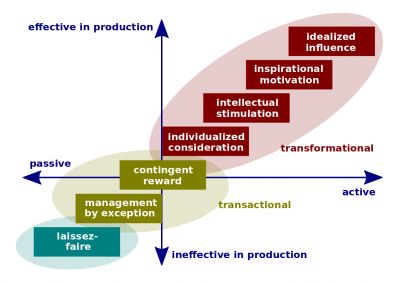Click here to view an explanation of ten leadership theories in five minutes.
In order to understand our current thinking on leadership, we need to look at how theories about leadership developed over the years. Studying leadership theories also help us to understand the characteristics of leaders better – i.e. how do we recognise and develop leaders.
Early leadership theories focussed on what qualities distinguished between leaders and followers, while later theories looked at factors such as the situation and skill level as determining factors of leadership behaviour.
We will look at four broad categories of leadership theories:
Great Man and Trait Theories
These theories assume that great leaders are born, not made. They are heroic, mythic, and destined to rise to leadership...
Later trait theories also assumed that certain traits make great leaders. These theories attempted to identify traits which would predict success in leadership roles.
John Gardner studied a large number of North American organizations and leaders and came to the conclusion that there were some qualities or attributes that did appear to mean that a leader in one situation could lead in another. These included:
- Physical vitality and stamina
- Intelligence and action-oriented judgement
- Eagerness to accept responsibility
- Task competence
- Understanding of followers and their needs
- Skill in dealing with people
- Need for achievement
- Capacity to motivate people
- Courage and resolution
- Trustworthiness
- Decisiveness
- Self-confidence
- Assertiveness
- Adaptability/flexibility

Criticism against trait theories:
- The assumption of these theories that certain traits would work anywhere from the battlefield to the classroom, is not necessarily correct. Recent research has emphasised that the environment and the type of subordinates play a role in the leadership style or approach required.
- Lists of traits are long – what happens when you have some of them but not all? In essence this question is about where do you draw the line if a leader is efficient or not.
- Traditional lists lean towards typical ‘male traits’. The raise of Emotional Intelligence as leadership trait has called to also include typical ‘female traits’ as effective for leaders.
Behavioural Theories
Great leaders are made, not born, says the behaviourists. People can learn to become great leaders through teaching and observation.

Blake and Mouton developed the managerial grid. Leaders lean either to a concern for people or to a concern for the task. The ideal leader is seen to have balanced the two in a participative leadership style.
McGregor said there are two underlying beliefs determining a leader’s style:
Theory X says people are generally lazy and would look for opportunities to sidestep work. A leader who believes this would generally be hesitant to delegate, check up on workers regularly and use punishment if goals are not met.
Theory Y suggests that people are inherently good, hard working and take pride in their work. The leader who believes in this theory would delegate readily, trust subordinates to do their best, create a motivating environment and develop subordinates to take more responsibility.
Criticism against behavioural theories:
- They assume that a leader’s style is static and that there is an ideal style to work towards, that would be ideal in all situations.
- These theories do not consider that a leader’s style might be dependent on the situation or environment in which the leader operates.
Contingency and Situational Theories
These theories focus on the environmental factors which influence the style that a leader adopts. No single leadership style is best, but rather the style suited to environmental factors such as the leader’s style, the followers and aspects of the situation.
Hersey and Blanchard developed the most comprehensive model of Situational Leadership. They said that there are three environmental factors influencing a leader’s behaviour:
- Task behaviour refers to how a leader define and organise tasks.
- Relationship behaviour refers to the extent to which a manager engage in two way communication with his/her subordinates.
- Maturity level of subordinates refer to the readiness of subordinates to execute a task.
The diagram below explain the model:

Criticism against Situational Theories: These theories were mostly developed in male-dominated North American environments. The impact of how culture and gender might influence the situation has not been explored. There might even be more environmental factors impacting a leader’s style…
Transactional and Transformational Theories
Transactional, also known as management theories of leadership, focuses on the leader’s role within the organisation such as supervision, task completion and group performance. These theories focus on reward and punishment to attain goals.
Transformational theories focus on the relationship between leaders and followers. Leaders motivate and inspire people by helping group members to see the importance and higher good of the task. Group performance as well as individual team member wellbeing are important. These leaders have high ethical and moral standards.
Burns distinguished as follows between the two:
- Transactional leadership means trading one thing off against another – as soon as you reach the goal I will pay you.
- Transformational leaders are visionary, seeking to appeal to follower’s better nature and move them towards higher and more universal needs and purposes. The leader is seen as a change agent.
Bass suggested that Transactional versus Transformational leadership should not be seen as two ends of a line, but rather as complementary. Three broad roles of a leader emerged from Bass’s theory:
- The team leader.
- The leader as a change agent.
- The leader as a strategic visionary.
Criticism against transactional and transformational theories: These theories are very broad and are philosophical rather than practical. They are therefore important to keep in mind, but very difficult (if not impossible) to use for recruitment and development purposes.
Full Range Leadership
The result of over a 100 years of research on leadership, basically using all knowledge, to come up with one model, was the work of Bass and Avolio. They came up with a model named the Full Range Leadership Model. This model advocates that efficient leaders have the ability to choose appropriately from any behaviour within the model suitable to what the environment requires.
The model identifies behaviours associated with transactional and transformational theories.
Transactional behaviours include:
- Laissez-Faire: Hands off leadership approach (Delegative leadership).
- Management by Exception: Putting out fires.
- Contingent awards: Let’s make a deal.
Transformational Leadership include:
- Individualised consideration: Compassionate leader.
- Intellectual Stimulation: Thinking outside the box.
- Inspirational motivation: Exciting the masses, sharing the vision.
- Idealised influence: Actions speak louder than words.

The model also has an impact on the debate and discussion about management versus leadership. It basically implies that the Transactional behaviours are more associated with management, whereas the Transformational behaviours are more associated with Leaders. This model further advocates that being an inspirational leader has a more effective outcome on subordinate behaviour than being more transactional.
Our approach in this course is to first expose you as a manager to the concept of inspirational leadership. This forms the backbone of a good manager. After that there are a number of courses to expose you to the role of the manager.